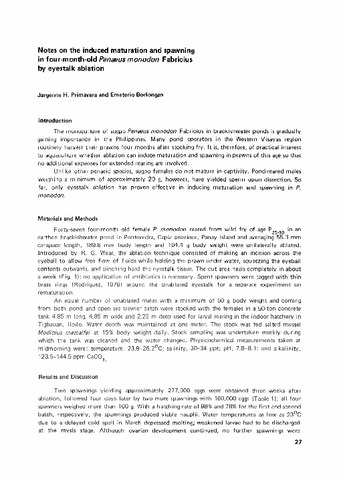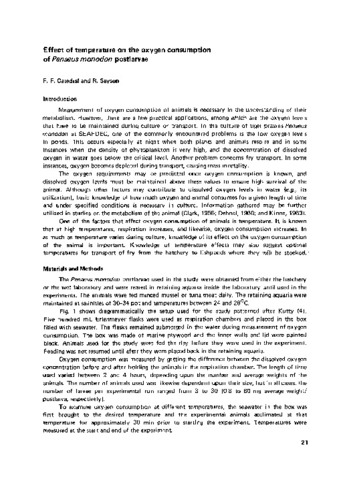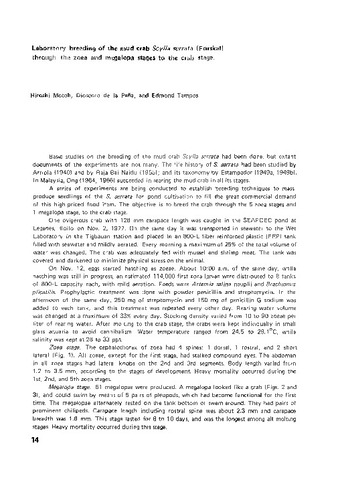公開日 のブラウズ: Institutional and Meeting Reports
1-20 / 290
-
First annual report of the Aquaculture Department of the Southeast Asian Fisheries Development Center (SEAFDEC) for the fiscal year ending December 31, 1973
(Aquaculture Department, Southeast Asian Fisheries Development Center, 1974)An illustrated account is presented, covering background (establishment of the department), plan of operation (functions; activities), project site development (Leganes Station, Tigbauan Station, construction of buildings, ... -
Annual report 1974
(Aquaculture Department, Southeast Asian Fisheries Development Center, 1975)The 1974 report describes the development of project sites at Tigbauan and Leganes, where new ponds and labs have been established. The facilities of these labs include covered and open ponds, wet and field labs, a food ... -
Annual report 1975
(Aquaculture Department, Southeast Asian Fisheries Development Center, 1976) -
Notes on the induced maturation and spawning in four-month-old Penaeus monodon Fabricius by eyestalk ablation
(Aquaculture Department, Southeast Asian Fisheries Development Center, 1977)The ablation technique consisted of making an incision across the eyeball to allow free flow of fluids while holding the prawn under water, squeezing the eyeball contents outwards, and pinching hard the eyestalk tissue. ... -
Bioenergetics of the freshwater prosobranch Idiopoma angularis Muller in Laguna de Bay
(Aquaculture Department, Southeast Asian Fisheries Development Center, 1977)This study was made as an attempt to investigate some of the ecological aspects of the freshwater snail Idiopoma angularis Muller in a modern framework of energy flow and mathematical models. It offers the first investigation ... -
Effect of temperature on the oxygen consumption of Penaeus monodon postlarvae
(Aquaculture Department, Southeast Asian Fisheries Development Center, 1977)Extended abstract only. -
Use of fermented kitchen waste in rearing Penaeus monodon larvae
(Aquaculture Department, Southeast Asian Fisheries Development Center, 1977)Fermented vegetable and kitchen wastes are available as feeds for not only zoea but also mysis and up to certain points in the postlarval stages of sugpo, Penaeus monodon. It is recommended that the hatchery use fermented ... -
Tolerance of Penaeus monodon larvae to cupric sulfate added in bath
(Aquaculture Department, Southeast Asian Fisheries Development Center, 1977)Copper is used to deter the growth of bacterial, fungal and protozoan disease organism in fishes. Zoeae (Z1), myses (M1) and postlarvae (P1) were exposed to copper sulfate at concentrations ... -
Preliminary chemical and physical evaluation of some formulated feeds for P. monodon
(Aquaculture Department, Southeast Asian Fisheries Development Center, 1977)The culture of Penaeus monodon has explicitly defined the need for diet formulations or supplementary feeds that would promote optimum growth and survival of the animal. A total of 28 feed combinations were developed for ... -
Preliminary biological evaluation of some formulated feeds for P. monodon
(Aquaculture Department, Southeast Asian Fisheries Development Center, 1977)Rice bran is widely used by fish farmers as supplementary feed while soybean cake is used both as feed and as fertilizer in fishponds. Both fish meal and shrimp head have been found acceptable as feed ingredients. However, ... -
The effect of various protein levels on the growth and survival rates of Penaeus monodon Fabricius
(Aquaculture Department, Southeast Asian Fisheries Development Center, 1977)Postlarvae of tiger prawns, P. monodon , were fed with various protein levels of 0; 30; 40 and 50%, fish meal and rice bran were combined and pelletized for 16 wks. Prawns used had an average mean length of 1.2 mm and an ... -
Amino acid analysis of P. monodon muscle
(Aquaculture Department, Southeast Asian Fisheries Development Center, 1977)Figures for the amino acid composition of Penaeus monodon, are tabulated, and compared to those for white tuna meat. -
Survival rates of different postlarval stages of Penaeus monodon Fabricius
(Aquaculture Department, Southeast Asian Fisheries Development Center, 1977)The objective of this study is to determine survival rates of different postlarval stages upon stocking in the Leganes ponds. Twelve 3m x 2m x 2m suspension nets made of nylon cloth (mesh size = 0.1 mm) were set up in a ... -
Land-based mass production of prawn (Penaeus monodon Fabricius) spawners
(Aquaculture Department, Southeast Asian Fisheries Development Center, 1977)The first spawnings were obtained 12 days after ablation with 4 spawners yielding 784,000 eggs and a harvest of 250,000 P10 fry. Survival of females after 1 month was approximately 30%. Mortalities were mostly ... -
Effect of some physico-chemical factors on the survival and growth of Penaeus monodon postlarvae
(Aquaculture Department, Southeast Asian Fisheries Development Center, 1977)Growth and survival rates of P. monodon postlarvae were examined at different temperatures, salinities, and nitrite and ammonia concentrations, using one feed level. Condition of postlarvae greatly affected the experimental ... -
Effect of different light intensities on the growth of the diatom Chaetoceros calcitrans
(Aquaculture Department, Southeast Asian Fisheries Development Center, 1977)Batch cultures of C. calcitrans were maintained indoors at a temperature range of 21 to 25 C and continuously illuminated by 40-watt daylight fluorescent lights. Cultures were exposed to 5 different intensities from 200 ... -
Effect of nitrite, ammonia, and temperature on P. monodon larvae
(Aquaculture Department, Southeast Asian Fisheries Development Center, 1977)P. monodon larvae were studied for the effects of temperature, ammonia, and nitrite on survival. Toxicity levels of nitrite were found to vary with larval stage. Larvae could tolerate ammonia up to about 10 ppm, with the ... -
Identification and culture of common diatoms as possible feed for Penaeus monodon
(Aquaculture Department, Southeast Asian Fisheries Development Center, 1977)Diatoms were collected from Buyuan Bay, and from the hatchery tanks at Tigbauan, to determine the commonly occurring species, the feasibility of culturing these species, and the potential of these selected species as food ... -
Laboratory breeding of the mud crab Scylla serrata (Forskal) through the zoea and megalopa stages to the crab stage
(Aquaculture Department, Southeast Asian Fisheries Development Center, 1977)A series of experiments is being conducted to establish breeding techniques to mass-produce seedlings of S. serrata for pond cultivation to meet the commercial demand for the crab. The objective is to culture the crab ... -
Effect of furanace on the development of larval stages of Penaeus monodon Fabricius
(Aquaculture Department, Southeast Asian Fisheries Development Center, 1977)Zoea 2 (Z2), Mysis 1 (M1) and Postlarva 1 (P1) of P. monodon artificially spawned in closed-system concrete hatchery tanks were bioassayed for their tolerance to the antibiotic furanace. ...





















